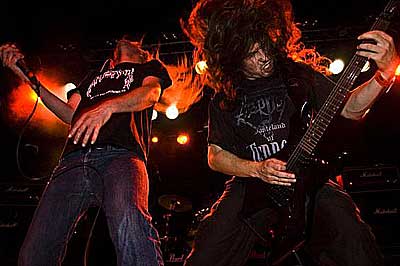The 90s was a creative feeding frenzy for metal. Artistic endeavour prospered, despite the irresistible pull of fiscal interests staking a claim on countercultures wherever they gained traction. The white heat of activity that saw heavy guitar music reach new zeniths of creative potential left much detritus in its wake. But whether metal was a new avant-garde attempting to explode accepted notions of modern composition or the acceleration counterculture’s final capitulation to consumer capitalism, there was no time to think of anything but the present. By the time the 2000s came a-knocking, temporal consciousness became an increasingly dominant preoccupation.
But contending with the real world events of the new century would prove to be outside the remit of expression within the metal format. Antaeus began the decade by claiming to be “anti-God, anti-music, anti-you”. There was no longer a meaningful way to respond to reality as it played out. Metal was moving out of phase with society and entering its post-modernity.
A computer in every home bred a new generation of quiet librarians and archivists attempting to document the anarchic frenzy of activity that was the 80s and 90s. Digital platforms stoked a new warzone, the stakes of which would define the very idea of artistic ownership. It was this, and not musical ontology itself, that would dominate fan narratives throughout the 2000s.

Nine Eleven, the Iraq War, financial collapse and the austerity that followed, all were met with a deafening silence from a metal community desperately contending – or hopelessly pre-occupied depending on your outlook – with the infrastructure through which their art was distributed and recorded, leaving little room for meaningful cultural responses to the decade that saw the West’s “end of history” chickens finally come home to roost. Whenever the idea of creativity or originality was raised, it wasn’t a spirited beer fuelled chat about the best new releases, it was an iconoclastic discussion about whether musical originality was even a possibility anymore.
Bleak as this outlook at first appears, it arguably sowed the seeds for the tentative revival we are seeing today. But before we pull together a sketchy unbroken narrative thread between then and now, we must dive deeper into metal’s extended hangover. If the 90s were the night before, the 2000s were certainly the morning after.
Music is made and understood in a very different way today than it was in 1999. The most significant developments to occur in the 2000s were technological rather than artistic. And the idea that metal’s tenure in the ICU throughout the decade was directly caused by social and cultural trends failing to keep up with the new infrastructure of modern music cannot be ignored.
With that in mind, it seems almost too perfect that the 2000s should have kicked off with the world’s richest metal band picking a fight with Napster. The budding file sharing site was able to pose as the plucky young upstart. This meant that whatever the rights and wrongs of Metallica’s actions, metal was now the establishment, willing to join the interests of capital in bullishly persecuting grassroots enthusiasm, punishing new DIY movements for their refusal to capitulate to yesterday’s institutional hegemony.
This was a grim metaphor, if anyone needed it, for the fact that metal had become the establishment’s useful idiot. The work of major labels, once considered a necessary evil bands had to contend with, was now undertaken by a volunteer army of internet users breaking the iron grip of big business on the means of distribution. This was the new engine room of counterculture, with the musicians themselves left to play catch-up. A dramatic role reversal that engendered a glut of woefully out of the touch moves by artists that found themselves living through these seismic shifts.
Despite Metallica’s victory in the courts over the file sharing trailblazers Napster, the cat was already out of the bag, with sites like LimeWire and Soulseek nurturing fledging online communities of file sharers. Music’s co-option into the limitless digital realm had a profound impact on the nature of fandom. Gone were the days of grassroots zines, austere record collectors saving up for the monthly purchase, and overworked promoters coordinating scenes from the ground up. Gone were the days of musicians claiming ultimate ownership over the raw artistic materials fuelling this culture. The early 2000s will be remembered as the dawning of a new age of atomised consumption.
Seen from this angle, the music nerd hunched over their computer begins to look like the logical conclusion to the overly obsessive metalhead trope already well established by the turn of the century. Armed with near limitless storage space, a hard drive stuffed with an Alexandrian archive of mp3s, and an iron will to document, categorise, and star-rate every moment of metal’s history to date, they were able to play out the endless distinctions and equivocations of the pre-gig drinking session in a new and permanent environment.
Online forums, blogs, chatrooms, and review sites like metal-archives allowed the fan to offer their musings up for posterity. A newfound permanence and significance was given to the interpretation of art and culture as a democratic, participatory arena, where all opinions have equal validity, visibility, and were distributed to a wider global audience than was ever possible, all in near real time. The past, present, and future of metal’s previously joyful spontaneity was brought to heel under the dictates of 24/7 commentary.
The architecture that made this breed of fandom possible was born of the internet’s Wild West days in the early 1990s. The promises of the internet’s earliest converts in this anarchic utopian phase are hard to understate. But by the time the internet inserted itself into the nuclear family’s home the purpose of this novel utility was unclear. Was it an educational resource? A means to book your next holiday? A way to connect with strangers? Or a new tool for shopping? The fact that it could do all of these things and more made the real potentialities spat forth by the internet’s self-styled prophets difficult to convey in bitesize chunks that could be readily digested by unassuming natives of consumer capitalism.
But for a new generation reaching their teenage years at the turn of the century (now dubbed millennials), this new tool would become the very means by which one’s personal identity was negotiated. Fandom of any kind became a choose-your-own adventure of sorts. Thanks to the tireless archival work of the internet’s earliest converts in the 90s, music fandom was suddenly no longer determined by time or place. Youth culture could be experienced and appropriated in its entirety from the comfort of home. Blogs, chat forums, and file sharing sites were the logical conclusion to what tape trading and underground zines had been aspiring to achieve in the 80s.
One no longer found themselves placed within a scene, city, or era. With a decent internet connection and enough storage space, one could amass more content for free than a teenager of the 80s or 90s would ever have dreamed possible. And thanks to the mp3 format, these bloated collections were readily portable, on devices far less cumbersome than the Walkman.
But if the Retromania complex had begun to determine how new fans were created, it had not yet explicitly bled out into metal music itself. Reading the 2000s as the total retreat of metal fandom into bedrooms and basements to quietly engage in compulsive (and free) cultural bureaucracy is only half the story. Retromania is not just a fixation with the past, one that sees any would be new music wilting entirely away. As should be obvious for anyone over the age of twenty, the 2000s also witnessed a glut of new music, modest by today’s standards but obscene in its excesses by any other measure.

From bedroom black metal, to Iron Maiden’s newfound mojo upon Dickinson’s return, to 70s revivalism in the juiced up stoner doom of Electric Wizard, to death metal’s frugal nods to maturity in Gorguts and Immolation, to releases from Slayer, Metallica, and Ozzy Osbourne that could be read as the last howl of the old guard, betraying their inability to digest what nu metal spelt for their artistic relevance.
Few today would attempt to make the case that this was a golden age. But the purpose here is not to once again revisit the litany of failures that metal enacted in response to this age of spiritually hollowed out melancholia that greeted the new century. The purpose here is to ask: what is Retromania? How did we get here and why does it matter?
One of the most important moments in metal was when it became self-conscious as metal. When a cultural movement reaches this moment of self-enlightenment it is negotiated almost entirely in terms of antithesis. We are either opposed to definitions, or guided by them, we are either suspicious of progression, or fixated on novelty, we are either us, or them. This complex originally took root in the late 1970s with the rise of NWOBHM and the bones of contention around what heavy metal was, whether the late 70s witnessed a “new wave” of it, and if this was the new wave then what was the old wave?
Heavy metal’s initial and naïve toe dipping into elitism laid the groundwork for every modern-day permutation found within its many subsets today. But its modern iteration could arguably be traced back to the early 2000s. Once those artists that had lived or grown up in the 90s sobered up from the reveries of the boisterous final decade of the 20th Century, a desperate “will-to-first-principles” struggle took place.
What do I mean by that? For the sake of argument, we’ll just say that the “will-to-first-principles” takes two forms. One stakes a claim on musical innovation and novelty but in actuality dredges the past for cues with a view to engaging in genre alchemy dressed up as genuine originality. This is a kind of sleight of hand Retromania. The second demands adherence to the old gods, declaring that anything that whiffs of “the new” is inherently suspect.
The real problem with the so called progressives was not their desire to shed the past, it was the fact that this claim often turned out to be a trojan horse deployed in order to secure metal’s final capitulation to capitalist branding. Self-identified progressive acts such Opeth, Enslaved, Mastodon, Meshuggah, and Gojira were not only ugly, disfigured chimeras from a musical perspective, but also essentially a brand. Whatever humble beginnings these acts started from, by the 2000s their logos and album art were merchandised, slapped on a plethora of household items like a sports brand.
With progressive metal’s full integration into the marketing machine, the art itself was negotiated through the dictates of financial prophet as well. This meant that any nod toward genuine musical innovation, unselfconscious leaps forward, striving for something entirely novel, all were effectively performative, a flavour used as a selling point in a crowded market.
Of course the opposite compulsion to explicitly reaffirm first principles was equally insipid. The moment Darkthrone realised that they no longer had anything meaningful to say as a black metal act they released ‘The Cult is Alive’ in 2006, a desperate plea that fans re-acknowledge their DIY credentials. This coincided with black metal’s attempt to appropriate old school rock in the lamentable black ‘n’ roll offshoot, something of a panicked retreat in the face of extreme metal’s symphonic and increasingly gauche operatic tendencies.

Death metal, for many years consigned to circling the same territory in search of an answer, would later discover the mileage that could be gained from simply repeating the past. The late 1980s was now long enough ago to be considered novel. Asphyx, Autopsy, Entrails, Atheist, and many more began to cash in on their own past. Respectable albums followed, in line with death metal’s better acquaintance with dignity than its black metal cousin. But this would usher in a seemingly unbreakable conflation between authenticity and old school values by the late 2000s.
The genuine and sincere compulsion to eke out new creative spaces was present in the 2000s, but its traction within a historically obsessed and non-scene orientated fanbase was limited. Averse Sefira, Gorguts, Crimson Massacre, Immolation, Beherit, and Antaeus shone like distant lights in a vast ocean, pushing at the boundaries of their respected specialties.
But underlying all of this, whether it be stoner doom’s brave march backwards, slick brands in the likes of Behemoth, Dimmu Borgir, and Dark Funeral, black metal’s plea for rock ‘n’ roll credentials, or death metal’s circling of the drain, underlying it all was the simple fact that metal had forgotten how to be spontaneous. The contradiction in terms found in the statement that one could “forget” how to create art free of premeditation immediately explains the intractability of this disposition.
Metal as a community of artisans was withering. It was morphing into a collective of atomised entrepreneurs, carefully honing their brand and niche within the market of ideas before releasing it into the world via the one-size-fits-all infrastructure of Web 2.0. Metal was not overtly fixated on the retro just yet, but the moment Asphyx released ‘Death…the Brutal Way’ in 2009, a newfound fascination with the past would take deep and lasting root. What made the proverbial old school great and why? How do we recapture that naïve yet addictive spirit of freedom and joyful creativity? These questions would obsess the modern musician.
The grassroots fixation with documenting the past on the one hand, and becoming one’s own promoter, label, producer, and manager thanks to the tools of social media on the other, all this meant that everyone was too busy to ask whether there was such a thing as too much content. This point goes well beyond the increasing volume of new releases and extends out into the number of discussion forums, fan reviews, retrospectives, big budget documentaries, interviews and star rating statistics. In being too aware of the past and how we got here, art could only ever exist as a direct response to this environment. The isolated, compulsive will to convey something deeper than words was absent without leave. Albums became appraisals of the present, one artist’s take on the state of the nation. Any authentic identity potentially sitting beneath this went uncommunicated.
In discussing Beethoven, the eccentric classical pianist Glenn Gould once said that all artists have within them something of the inventor and the museum curator, and that all great works were the result of a momentary gain of one over the other. For metal, by the end of the 2000s, this equilibrium had been entirely lost, with the museum curator well and truly winning the day.

Metal’s Retromania Part II: the great explosion
Metal’s Retromania Part III: the eternal return